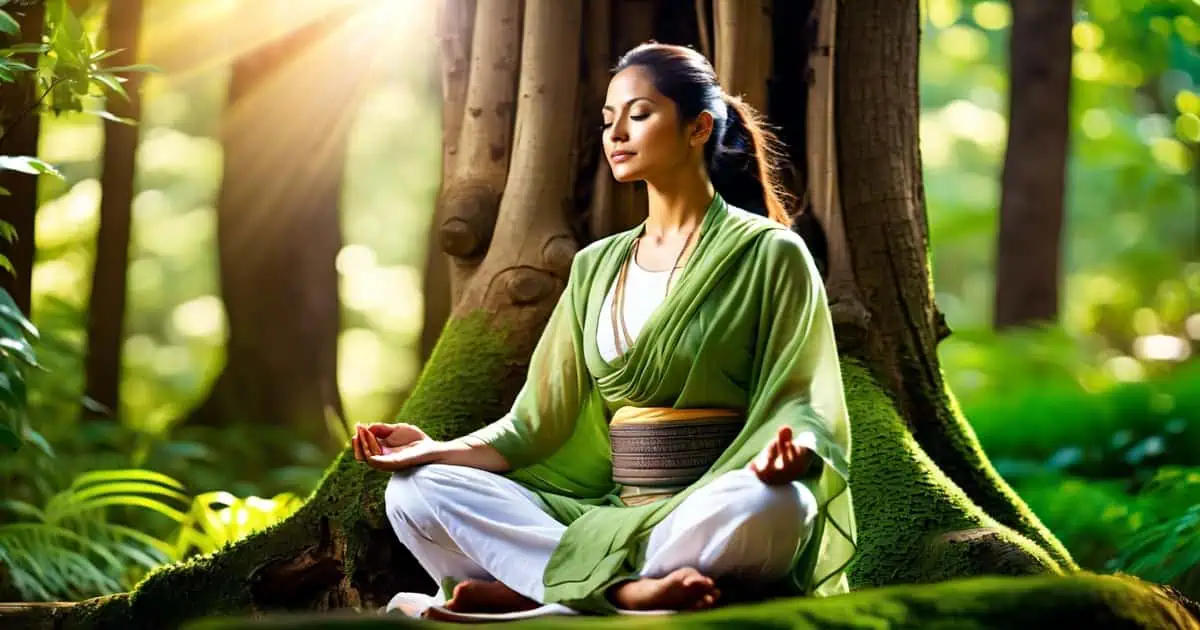Key Takeaway
Gratitude yoga is a way of being thankful for who we are and what we have. It helps us deal with negative and stagnant thinking, which is something that happens naturally in our minds. By practicing it, we can find new perspectives that make us feel good and appreciate what we have.
As I embark on my exploration of gratitude yoga, my goal is to uncover the essence of this tradition and shed light on its unique benefits.
This is not just another yoga class but rather a transformative journey that intertwines physical poses with the profound cultivation of thankfulness, weaving in various elements that enhance the overall experience.
By focusing on intention, this approach elevates the experience to nurture not only our bodies but also our minds and spirits. Join me as we delve into the intricacies of this philosophy and unlock a deeper understanding of its many benefits.
Contents
Origins and Essence of Gratitude Yoga
Historical Roots
Gratitude yoga, as a technique, has ancient ties. It stems from the broader traditions of yoga that date back thousands of years in India. The focus on gratefulness within these practices is not new but has gained more attention recently.
In my journey with yoga, I’ve learned that thankfulness is woven into many yogic teachings. It’s about seeing the good in every moment and being thankful for life itself. This mindset aligns with historical philosophies where contentment (Santosha) is central to well-being.
Core Principles
The core principles of this yogic philosophy revolve around mindfulness and appreciation. Practitioners are encouraged to cultivate a positive and negative attitude of thankfulness for their experiences.
I find this approach transformative because it shifts focus from what we lack to what we have. In my experience, this shift can lead to increased happiness and reduced stress.
Traditional Teachings
Traditional teachings inform the approach by emphasizing interconnectedness and generosity. Ancient texts like the Vedas discuss giving thanks as part of one’s daily rituals.
Personally, integrating these age-old concepts into my routine has been enlightening. They remind me that expressing thanks can create ripples of positivity beyond our immediate environment.
Expressing Gratitude through Yoga Poses
Gratitude Poses
Yoga offers many poses that embody thankfulness. The Child’s Pose is one such example. Here, you kneel and bow forward, touching your forehead to the ground. This pose resembles a gesture of reverence and surrender.
Another meaningful posture is the Warrior I. You raise your arms towards the sky as if you are receiving blessings or giving them to someone else.
In my practice, I find these poses help me feel grounded and connected to something larger than myself.
Emotional Effects
Each yoga pose stirs different emotions inside us. The heart-opening poses, like the Cobra or Camel Pose, literally open up the chest area. They can release joy and promote an inner sense of thankfulness.
The act of opening our hearts in these poses makes room for more positive feelings. For me, practicing these movements often brings a wave of happiness that stays with me even after my session ends.
Infusion Tips
To infuse gratitude into every movement:
- Start each session by setting an intention centered on gratitude.
- Focus on breath work; inhale positivity, exhale negativity.
- Use affirmations during transitions between postures: “I am thankful for this moment.”
Remembering these tips helps deepen my connection to both yoga and appreciation during practice.
Motivational Calendar - Daily Flip Calendar with Inspirational Quotes - Inspirational Desk Decor for...
See latest price
Mindful Breathing for Grateful Living
Breathing Techniques
Breath is the essence of life. It’s also a bridge to thankfulness. I find that certain breathing methods can make me feel more grateful. One technique is deep diaphragmatic breathing. This involves taking slow, deep breaths through the nose, allowing the belly to rise, and exhaling gently.
Another method is 4-7-8 breathing. Here’s how it works:
- Breathe in quietly through the nose for 4 seconds.
- Hold the breath for 7 seconds.
- Exhale completely through your mouth, making a whooshing sound for 8 seconds.
These techniques help calm our mind and body.
Grateful Mindset
Connecting breathwork with gratitude strengthens our mindset. We become anchored in the present moment when we focus on our breaths. This awareness makes us appreciate everything more.
To cultivate this habit:
- Start or end your day by taking five mindful breaths.
- Think of one thing you’re thankful for with each inhale and exhale. I’ve personally found that doing this daily increases my sense of contentment significantly.
Personalized Gratitude Yoga Sessions
Individual Needs
Gratitude yoga becomes more impactful when it fits individual needs. Each person’s physique and mind respond differently to yoga practices. Tailoring sessions can support meeting specific health goals or emotional states. For example, someone recovering from an injury might need gentle movements focused on healing.
A Yogi’s Guide To Joy, drawn from Sadhguru’s wisdom, is a 15-day journey towards freedom from suffering, mastery of your thoughts and emotions, and lifelong bliss.
Listening to my body during practice enhances the benefits of this yogic philosophy. The personal attention ensures that each pose and breath work serves a purpose for my well-being.
Goal Alignment
Aligning yoga with personal goals makes the practice meaningful. If stress reduction is the aim, incorporating mindfulness into sessions can be helpful. When seeking physical strength, poses like Warrior II become key elements in a routine.
My experience has taught me that setting intentions before starting helps me stay focused on my goals throughout the session.
Custom Adjustments
The beauty of this yoga lies in its adaptability. Making small adjustments can create a unique experience for each individual. A personalized playlist or choosing a serene environment may deepen one’s sense of gratitude during the workout.
Sometimes, I adjust my surroundings by adding candles or soft lighting to enhance tranquility within my space, making every session special and tailored just for me.
Yogi Gift Yoga Lover Gift Relaxation Candle Yoga Candle Gift for Yoga Instructor Funny Gift Namaste
See latest priceThe Impact of Gratitude on Well-being
Health Benefits
Studies show that gratitude can lead to better health. People who use this approach report fewer aches and pains. They also tend to visit the doctor less often. This suggests a strong link between gratefulness and physical health.
I’ve noticed changes after starting gratitude yoga. My sleep improved, and headaches became rare. These personal experiences align with research findings.
Mental Advantages
Gratefulness boosts mental health as well. It increases happiness and reduces depression symptoms. Regular practice helps people feel more positive emotions.
I remember being overwhelmed by stress at one point in my life. After incorporating offering and appreciation into my daily routine, my outlook changed dramatically.

Emotional Growth
Practicing gratefulness can enhance your emotional well-being, too.
- It fosters deeper relationships.
- You learn to appreciate the goodness in your life.
- Your overall satisfaction improves.
As someone who struggled with acknowledging good things, practicing gratefulness made me more receptive to kindness from people.
Fostering Connection with Loving Kindness Yoga
Empathy Exercises
Loving-kindness yoga is a path to deepen empathy and connection. This approach involves exercises that open the heart. One might begin by focusing on one’s breath, imagining love flowing in and out. Then, they send well wishes to themselves, loved ones, strangers, and even those they have conflicts with.
I’ve found this method particularly transformative. I feel a sense of unity with people by sending positive thoughts outwardly during my sessions. It’s as if invisible threads of compassion tie us together.
Conclusion
Throughout this exploration of gratitude yoga, I’ve highlighted its transformative power—from its roots to the practice’s ability to enhance well-being.
I’ve detailed how incorporating gratefulness into yoga poses, mindful breathing, and community practices can profoundly impact our lives, fostering deeper connections and promoting joy across all ages and settings.
The evidence is clear: embracing gratefulness within our yoga routine is not just beneficial; it’s essential for a holistic approach to health and happiness.
I urge you to integrate these insights into your daily routine. Start small, perhaps with a personalized session or a simple act of loving-kindness, and observe the shifts in your mind and body.
Let’s embark on a journey towards a more grateful living together. Share your experiences and join our email newsletter to get inspired alongside others on their path to wellness. You can also receive more great information like this in your inbox from time to time.
Frequently Asked Questions
What is gratitude yoga?
Gratitude yoga is a method that combines traditional yoga poses to cultivate an attitude of gratefulness. It involves mindfulness and appreciation for the present moment.
What is the yoga mantra for gratitude?
A commonly used mantra in gratitude yoga is “So Hum,” which can be translated to “I am that.” This mantra helps practitioners connect with a sense of universality and gratefulness.
What is the gratitude technique in yoga?
The gratitude technique in yoga often includes mindful breathing, setting intentions of thanks before a workout, integrating positive affirmations during postures, and reflecting on aspects of life one appreciates after sessions.
What are the four steps to practicing gratitude in yoga?
The four steps include – 1) recognizing what you are grateful for, 2) acknowledging it within yourself or out loud, 3) feeling and expressing appreciation through asanas or meditation, and 4) reflecting on the sensations and emotions experienced during this process.
How does expressing gratitude through yoga poses work?
Expressing gratitude through yoga poses works by focusing one’s awareness on feelings of thankfulness while holding each posture. This intentional focus enhances emotional well-being alongside physical benefits.
Can community practices enhance my experience with gratitude yoga?
Yes, community practices can amplify your experience by sharing collective energy and joy. Practicing with others fosters connection and amplifies feelings of appreciation within group settings.
Does practicing loving kindness (Metta) Yoga relate to Gratitude Yoga?
Practicing Metta or loving kindness yoga complements Gratitude Yoga as both cultivate positive emotions towards oneself and others. They foster connection by encouraging an open heart full of compassion.








Thank you for featuring these heart-opening poses and breathing practices! It is wonderful to read an article that focuses on how yoga can open doorways to feeling deeper levels of gratitude.